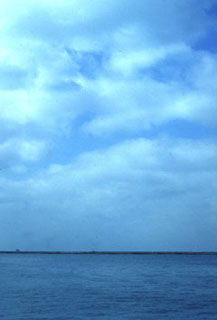about here, now

Blower with computer-controlled damper,
slide projection, Internet connection, Macintosh computer.
1996.

Blower with computer-controlled damper,
slide projection, Internet connection, Macintosh computer.
1996.
This telematic artwork was presented in the exhibition, “Remote Sensing” at the
University of West Virginia (March 1996). An outdoor sensor at the School of the
Art Institute of Chicago gathered local wind data; this was transmitted via file
transfer protocol to a computer at UWV. In the gallery, viewers noticed a door in
the gallery wall cracked open, inviting them to peer inside. There they saw a rear
(slide) projection of Lake Michigan (cf. illustration) and felt air gusting into
their faces as a computer-controlled damper modulated a blower’s output into a facsimile
of the wind in Chicago. Mirror columns behind the projection screen turned in the
air currents, so that fragments of the image traversed the projection surface as
visual indicators of wind movement.
The telepresence aspect of the work consists of the consciousness instigated in the
viewer of the provenance of the “wind” being felt in the gallery. This awareness
of another place, separate from the viewer -- indeed, indifferent to them -- may
provoke a consideration of one’s spatial limitations, and how these can be transcended
by consciousness.
The artist feels this piece was only moderately successful, owing to the difficulty
of viewers knowing what was happening, without simply being told. Indeed, this is
a central problem, endemic to the (for the public) still-unfamiliar form of telepresence
art -- how to subtly convey the knowledge of the link with remote space, needed for
an appreciation of the work -- in a way that is inherent in the work. Without the
realization that the “wind” they were feeling “came from Chicago,” viewers understandably
had a “So what?” reaction. Once they were told, they generally found the piece fascinating.
Future versions of this work will probably expose the technology, providing “clues”
for the viewers in their attempt to understand the piece.
Currently, tele-artwork is a burgeoning, fascinating field of work requiring considerable
technical expertise and special equipment; before long, however, it will likely become
commonplace, thus losing some of its “cutting edge” allure and capacity to surprise
(or confuse), but also becoming more accessible to artists as a tool for creating
aesthetic meaning.